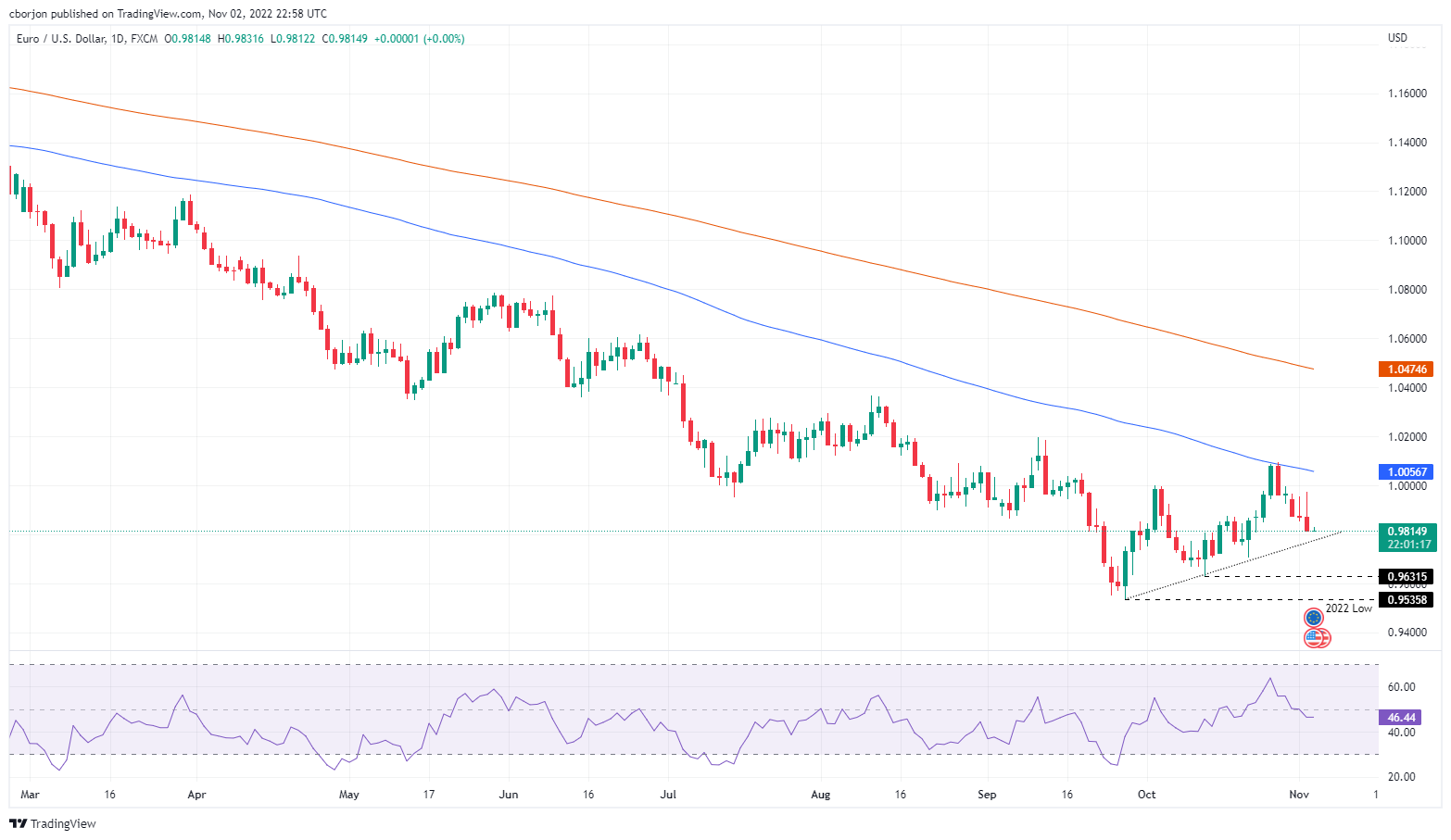- Analytics
- News and Tools
- Market News
- EURUSD plunges 150 pips from weekly highs on Powell’s hawkish remarks after Fed rate hike
EURUSD plunges 150 pips from weekly highs on Powell’s hawkish remarks after Fed rate hike
- The Euro is at the mercy of a hawkish Federal Reserve, as Eurozone PMIs show a recession is lurking.
- The Federal Reserve’s dovish statement and a hawkish Jerome Powell spurred turmoil in the market, benefitting the safe-haven American dollar.
- The EURUSD downtrend remains intact, and once sellers clear 0.9770, a test of the 2022 lows is on the cards.
The Euro tumbled against a buoyant US Dollar on Wednesday, following the release of a dovish perceived US Federal Reserve (Fed) 75 bps rate hike, on which the EURUSD rallied and hit a fresh weekly high at 0.9975. However, Jerome Powell, the Chairman of the Federal Reserve, turned hawkish, sending the markets into turmoil, while the safe-haven USD pared its earlier losses. At the time of writing, the EURUSD is trading at 0.9814, at fresh weekly lows, as the Asian session begins.
Jerome Powell lifted the USD to the detriment of the EUR
Sentiment shifted sour after the Federal Reserve decision, but volatility increased once Jerome Powell took the stand. In its Q&A, Powell said that interest rates in the United States would go higher than September’s projections, a powerful “hawkish” statement that sent the EURUSD diving from around 0.9975 to 0.9827, almost a 150 pip drop. It should be noted that the Federal Reserve Open Market Committee (FOMC) monetary policy statement was slightly dovish, as shown by the EURUSD bouncing from around 0.9860 toward its weekly highs, on a sentence that mentioned: “the Committee will take into account the cumulative tightening of monetary policy.”
High inflation and a tight labor market in the United States will deter a Fed pivot
Even though the Fed’s “cumulative tightening” of 375 bps In the year shocked some parts of the United States economy, like housing, inflation remains stubbornly high, the unemployment rate is low, and job vacancies are rising, which means the Fed has work to do.
Regarding that, in its monetary policy statement, the Federal Reserve Open Market Committee (FOMC) noted that ongoing increases will be needed to a restrictive level to bring inflation to the 2% goal. Meanwhile, for the Federal Reserve’s December meeting, money market futures expect a 50 basis points move to the Federal funds rate (FFR), peaking by the end of the year at 4.25-4.50%
Interest rate differentials and a Eurozone recession looming will keep the EURUSD on the defensive
Therefore, the Euro might be under pressure due to interest-rate differentials between the Fed and the European Central Bank (ECB). Albeit both institutions are laying the ground for a slower pace of interest rate increases, the United States will enjoy rates at 4.50% by the end of 2022, while the Eurozone will likely be at 2%. Also, Manufacturing PMIs from the Eurozone flashing a recession contrarily to the United States will undermine the appetite for the Euro. Therefore, the EURUSD will retain its downward bias.
EURUSD Price Analysis: Technical outlook
The EURUSD downtrend is intact, though it should be noted that sellers did not have the strength to clear the 0.9800 figure, which could have opened the door for a YTD challenge at 0.9535. Even though the Relative Strength Index (RSI) suggests that selling pressure is mounting, a one-month-old upslope trendline drawn from YTD lows that pass at around 0.9770 should be broken to pose a real threat for EURUSD buyers. Once cleared, the next demand zone would be 0.9700 and the October 13 low at 0.9631.

© 2000-2024. All rights reserved.
This site is managed by Teletrade D.J. LLC 2351 LLC 2022 (Euro House, Richmond Hill Road, Kingstown, VC0100, St. Vincent and the Grenadines).
The information on this website is for informational purposes only and does not constitute any investment advice.
The company does not serve or provide services to customers who are residents of the US, Canada, Iran, The Democratic People's Republic of Korea, Yemen and FATF blacklisted countries.
Making transactions on financial markets with marginal financial instruments opens up wide possibilities and allows investors who are willing to take risks to earn high profits, carrying a potentially high risk of losses at the same time. Therefore you should responsibly approach the issue of choosing the appropriate investment strategy, taking the available resources into account, before starting trading.
Use of the information: full or partial use of materials from this website must always be referenced to TeleTrade as the source of information. Use of the materials on the Internet must be accompanied by a hyperlink to teletrade.org. Automatic import of materials and information from this website is prohibited.
Please contact our PR department if you have any questions or need assistance at pr@teletrade.global.















